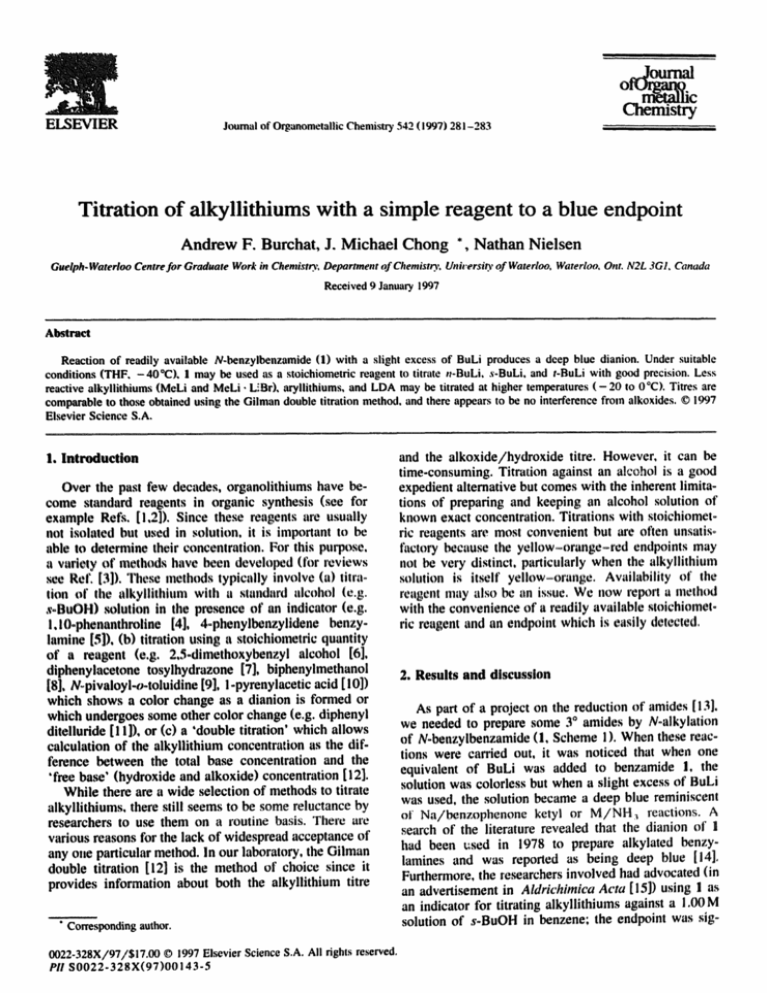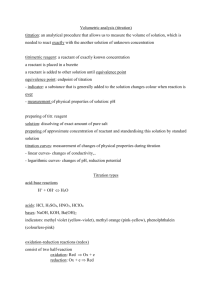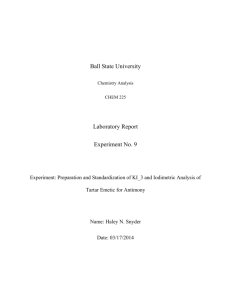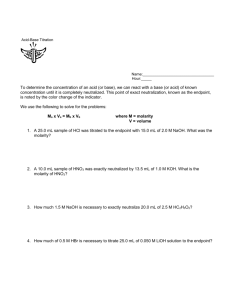
ELSEVIER
o
Chemistry
Journal of Organometallic Chemistry 542 (1997) 281-283
Titration of alkyllithiums with a simple reagent to a blue endpoint
Andrew F. Burchat, J. Michael Chong *, Nathan Nielsen
Guelph-Waterloo Centrefor Graduate Work in Chemisto, Department of Chemisto'. University of Waterloo. Waterloo. Ont. N2L 3GI. Canada
Received 9 January !997
Abstract
Reaction of readily available N-benzylbenzamide (I) with a slight excess of BuLi produces a deep blue dianion. Under suitable
conditions (THF, -40*(2), 1 may be used as a stoichiometric reagent to titrate n-BuLl, s-BuLi, and t-BuLi with good precision. Less
reactive alkyllithiums (MeLi and MeLi, LiBr), aryllithiums, and LDA may be titrated at higher temperatures ( - 20 to 0°C). Titres are
comparable to those obtained using the Gilman double titration method, and there appears to be no interference from alkoxides. © 1997
Elsevier Science S.A.
1. Introduction
Over the past few decades, organolithiums have become standard reagents in organic synthesis (see for
example Refs. [1,2]). Since these reagents are usually
not isolated but used in solution, it is important to be
able to determine their concentration. For this purpose,
a v~riety of methods have been developed (for reviews
see Ref. [3]). These methods typically involve (a) titra°
lion of the alkyllithium with a standard alcohol (e.g.
soBuOH) solution in the presence of an indicator (e.g.
1,10.phenanthroline [4], 4°phenylbenzylidene benzylamine [5]), (b) titration using a stoichiometric quantity
of a reagent (e,g, 2,5.dimethoxybenzyl alcohol [6],
diphenylacetone tosylhydrazone [7], biphenylmethanol
[8], N-pivaloyi-o-toluidine [9], i-pyrenylacetic acid [10])
which shows a color change as a dianion is formed or
which undergoes some other color change (e.g. diphenyi
ditelluride [1 I]), or (c) a 'double titration' which allows
calculation of the alkyllithium concentration as the difference between the total base concentration and the
'free base' (hydroxide and alkoxide) concentration [12].
While there are a wide selection of methods to titrate
alkyllithiums, there still seems to be some reluctance by
researchers to use them on a routine basis. There are
various reasons for the lack of widespread acceptance of
any one particular method, in our laboratory, the Gilman
double titration [12] is the method of choice since it
provides information about both the alkyllithium titre
" Corresponding author.
0022-328X/97/$17.00 © 1997 Elsevier Science S.A. All rights reserved.
PI! S0022-328X(97)00143-5
and the alkoxide/hydroxide titre. However, it can be
time-consuming. Titration against an alcohol is a good
expedient alternative but comes with the inherent limitations of preparing and keeping an alcohol solution of
known exact concentration. Titrations with stoichiomet°
tic reagents are most convenient but are often unsatiso
factory because the yellow-orange-red endpoints may
not be very distinct, particularly when the alkyllithium
solution is itself yellow-orange. Availability of the
reagent may also be an issue, We now report a method
with the convenience of a readily available stoichiometo
ric reagent and an endpoint which is easily detected.
2. Results and discussion
As part of a project on the reduction of amides [13].
we needed to prepare some 3° amides by Noalkylation
of N.benzyibenzamide (1, Scheme 1). When these reactions were carried out, it was noticed that when one
equivalent of BuLi was added to benzamide I, the
solution was colorless but when a slight excess of BuLi
was used, the solution became a deep blue reminiscent
ot' Na/benzophenone kety| or M/NH~ reactions. A
search of the literature revealed that the dianion of 1
had been used in 1978 to prepare alkylated benzylamines and was reported as being deep blue [14].
Furthermore, the researchers involved had advocated (in
an advertisement in Aldrichimica Acta [15]) using 1 as
an indicator tbr titrating alkyllithiums against a 1.00 M
solution of s-BuOH in benzene; the endpoint was sig-
~2
A.F. Burc~t et al. / Journal of Organomemllic Chemistr)' 542 f ! 997) 281-283
-"--*
/'~Plt
OMF
oolm~m
1-
0
R
Scheme I.
rmled by a change in color from blue to red to colorless.
However. since this method .~ems to have been overlooked by chemists (this reagent is not mentioned in any
of the recent reports on alkyllithium titrations [3.5-11 ].
possibly becau~ 1.10-phenanthroline had already been
established as a good indicator in such titrations) and.
since 1 is a crystalline, non-hygroscopic, readily available material (Aldrich #20.101-4: l,at~caster #0800).
the possibility of using it as a stoichiometric titrant
~emed worthy of further investigation.
After some expedmentaton, it was found that a
solution of 1 in THF (it is only sparingly soluble in
ether) could be titrated to a blue endpoint using BuLi
with good precision. The main variable considered was
temperature: at O°C or room temperature, the endpoint
was very distinct but faded after a few seconds to
minutes: at --78°(3.. the blue color persisted we!! but
was ~low to develop. At =40°C. the endpoint was
distinct and the blue color persisted (30--40rain).
We titrated a number of alkyllithiums using 1 under
these conditions and compared the results to titres obtained using the Gilman [12] double titration (Table 1).
It is apparent from these results that there is generally
excellent agreement between the Gilman double titration results and the results using 1. It is noteworthy that
different samples of BuLl containing widely varying
amounts of "free base' all gave good results, suggesting
that there is little or no interference from such impurities. Samples of s-BuLl and t-BuLl also gave good
results when titrations were carried out at -40°C. For
MeLt and MeLt- LiBr, the blue color was very slow to
develop at - 4 0 ° C : satisfactory results were obtained at
- 2 0 ° C and O°C, respectively. Similarly, PhLi and
4-MeOC6H4Li were best titrated at O°C. The higher
temperatures required for these alkyilithiums and aryllithiums is understandable given their lower
has±city/reactivity.
We also investigated the use of 1 to titrate lithium
am±de ba~s and Grignard reagents. LDA could be
titrated with good precision but LiHMDS and NaHMDS
did not produce a blue color even when added in large
excess, This difference in behavior between LDA and
bis(trimethylsilyl)amides is likely due to the very large
difference in base strengths (pK,~ of 35.7 for i-Pr, NH
vs. 29.5 for HMDS [2]). Grignard reagents (e.g~ nBuMgBr. ioPrMgCl) also did not produce a blue color
with I, reflecting their much poorer metalating ability in
comp~son with alkyllithiums.
It i~ interesting to note that the A,,,~, for a number of
Tahte I
Titritlio, of alkylliihium~ with N.l~il~ylMn~amide (I)
Smllple *'
Nomm:d
eo~eoirathm (M)
Tttre umng Gilman double titration ~'
Total (M)
lal~ (M)
RLi {M) '~
Tm~ usiil$ I I M ) '
BuLl A e
BuLt B ~
BuLl C ~
BuLi
,~-BuLi
vBuLi
M~Li. LtBr h
[hLi ~
PhLI h,l
4oM~K~ H~Li I~,l
LDA *'*'
1,6
I,6
I,~
2.~
1>3
I,?
I.'1
1.4
!,2
1,2
0,8
I>~
I,~8
1,68
2,77
1.0l
l,!tl
ll.~)
1.68
1.25
O,fl8
--
1.48 ±
1)~?~ ±
1.20 ±
2,49 ±
0,$? ±
I,?$ ±
O.Yl ±
I.$2 ±
1,20 ±
0,62 ±
0,~1 ±
0+14
0>88
O.4~
023
0.15
0,07
032
0.15
0.03
II,(LI,
--
1~$2 +-~' 02
0 3 0 ± 0.(~
123 ±O.O2
2.~4 ± 0.03
O.$~ ± 0,O4
I.?? ± O,O.'lt
0.18 ± 0.04
I,$.~± 0 . I I
I , ~*
. . ± 0,05
0,63 ± 0,02
--
0.03
0.01
0.O4
0.03
0.02
0o0."I
O.02
tLOI
0,01
0,01
0,01
* All alkylllthium .~olultim~ were c o m n ~ : i , I .~ampl,e.~in S u l ~ a l ~ ~ t l e s t~tail~t i'~ml Aldrich Cl~niicaI Conipany.
Titration+ w+~ c ~
ou| tt~2otw¢liil~|o Ret'. 112] usm+ i,2odiblxmv{veihan¢.
' The titre i~ ~ r t ~ d o~ T _÷ ~ r , fo~ triplicate determinations
'l Ctm~enwal/~ms ~po~¢d are the average ~plicate determmauons. V ~ r s are rep~med as lhe sum of ~ _ , for eiL~:liof |he |~o UtFations
inv~d~d.
A 2 )'ear-old llottle ¢octtaining considerable amour, Is of ~ i m e m ,
A ~ m~mth.~d b~mle,
T i l r a l ~ ~ith I was c a m ~ out at O'~C.
T i t r a t ~ ~'ith I was ± a m ~ out at ~ ~} ~C,
~
by ~klitio~ of ~-BuLI to i-Pr, NH in TtIF at -.'41 ~C.
A.F. Bun'hat et a l . / Journal olOrgmtometallic Chemisto" 542 ¢1997J 2,~1-283
other indicator dianions have been reported, and are in
the range 440 (N-pivaloyl-o-benzylaniline) [9] to 483 nm
(4-biphenylmethanol) [8]; these numbers are consistent
for yellow-orange solutions. Indicators with red endpoints presumably would have A,,a, = 490-500 nm [ 16].
By comparison, the blue dianion from 1 exhibits Amax
= 573 nm (THF, 0 °C).
In summary, N-benzylbenzamide (1) may be used as
a stoichiometric reagent to titrate alkyllithiums, aryllithiums and LDA in a simple straightforward manner
with good precision and accuracy with minimal interference from alkoxides. The ready availability of 1 (or the
inexpensive synthetic precursors to it), the case with
which it is handled, and the distinct blue endpoint
which arises from it make it a very attractive reagent.
3. Experimental section
3. I. N-benzylbenzamide (1)
Benzylamine (10.4ml, 95mmol) was added to a
solution of benzoyl chloride (11 ml, 95 mmol) and EtaN
(20ml, 143retool) in CH,CI, (20Oral). After stirring at
room temperature tbr 2 h, the mixture was washed with
I M HCI (2 × 50mi) and brine (50ml). Drying and
concentration of the organic layer afforded I as a
yellow solid: recrystallization from hexane/EtOH gave
while needles (17.6g. 88%). M.p. 105-106°C: lit. [17]
m.p. 105-106°C.
3.2. General prot'edure ,liar titration of' alkyllithitons
ttsltt,q I
A dry 25 ml |wo-neeked tlask fitted with a magnetic
stirring bar, an Ar inlet and septum is charged with I
(100=300rag) and dry {Na/Ph:CO) THF (10ml). The
solution is cooled to =40°C (dry ice/ethylene
$1ycol:H_~Oo I'1) and the alkyllithium solution is added
dropwise via syringe. The colorless solution turns blue
as each drop of RLi solution hits it but the color quickly
( < I s) dissipates; the endpoint is indicated by a persistent light blue color. At this point, the addition of a
283
single drop of RLi solution ~ves an intense ink-blue
color.
Acknowledgements
We thank the Natural Sciences and Engineering Research Council (NSERC) of Canada for financial support and S. Clugston for assistance in obtaining UV
spectra.
References
[I] BJ. Wakefield. Organolithium Methods. Academic Press. London. 1988.
[2] M. Gray. M. Tinki. V. Snieckus. Lithium. in E.W. Abel. F.G.A.
Stone. G. Wilkinson (Eds.). Comprehensive Organometallic
Chemistry il, Vol. I I. Elsevier Science. Oxford. 1995, pp.
1-92.
[3] B,J. Wakefield, Organolithium Methods. Academic ~ s s , London. 1988, pp. 16=19: M. Gray. M. Tinkl, V. Snieckus, Lithium.
in E.W, Abel, F.G.A. Stone. G. Wilkinson (Eds,). Comprehensive Organometallic Chemistry !1. Vol. I I. Elsevier Science.
Oxford. 1995, p. 3; AIdrichim. Acta 21 (1988) 14.
[4] S.C, Watson. J,F. Eastham, J, Organomet. Chem. 9 (1967) 165,
[5] L. Duhamel, J,-C, Plaquevent, J. Organomet. Chem, 448 (1993)
I.
[6] M.R. Winkle. J.M. Lansinger. R.C. Ronald. J. Chem. Sty'..
Chem. Commun. (1980) 87.
[7] M.F, Lipton, C.M, Sorensen, A.C, Sadler. R,H, Shapiro, J~
Organomet. Chem, 186 (1980) 155,
[8] E, Juaristi, A, Martine~oRieha, A, Gar¢iaoRivcra, I,S Cnteo
Sanche~. J, Ors, Olem, 48 (1983) 2fd)3,
[9] J, Suffert. J Or S, Ghent, ~4 (1989) 509,
[10] H, Ki[junen, T,A, Ha~e, J, Ors Cltem, 5h (1991) 69~o
[11] Y, Aso, H, Yal|tasllita, T, Otsnho. F, Ost=ra, ,i, Or~, Chem, 54
(1¢}80) 5¢~27,
[12] H, Gilman, F,K Canledse, J, Organomet, Chem, 2 (1~4) 447,
[13] A,F, Bul~hat, M,Sc. Dissertation, University of Wate,rh:~,, 1091;
A,F. Burehat, J,M, Chon$, N, Nielsen. J, Ors. Chem, 61 (1996)
7~27.
[14] A.N. Tischler, M.lt. Tischler, Tel,'ahedron Left, (1978) ~,
[15] Aldrichim. Acta II (1978) 20.
[16] R.L.M. Allen, Colour Chemistry, Appleton~Cenlury°Crofts. New
York, 1971, p. 2.
[17] Dictionary of Organic Compounds. Vol. I. Chapman and Hall.
London, 6th ed,. 1991~, p. 693,








